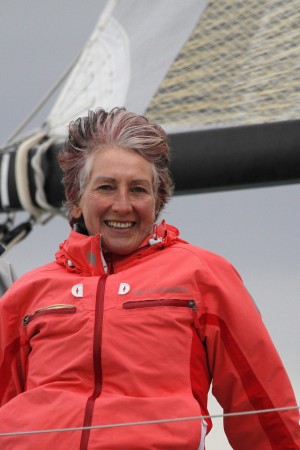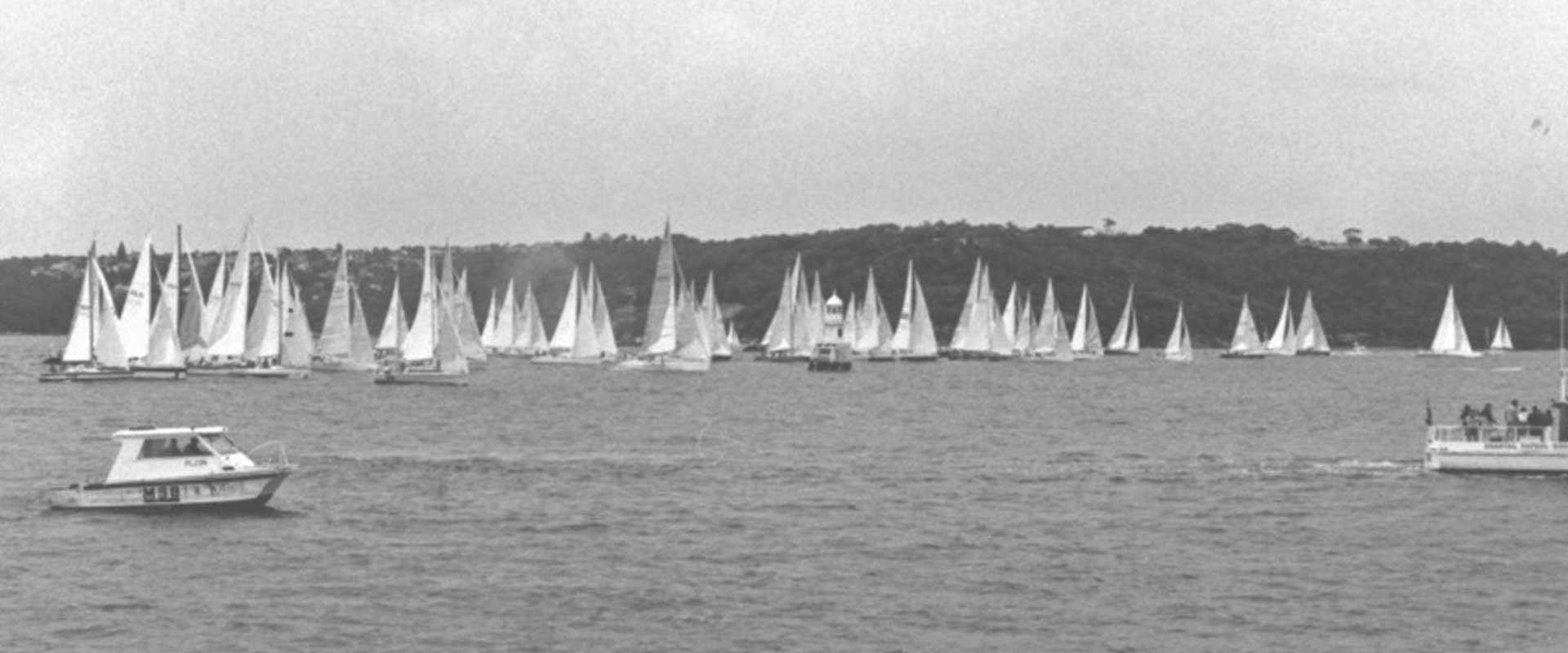| Kerry Goudge | |
|---|---|
 Kerry Goudge - photo taken by Geelong photograperTerri Dodds | |
| Gender | Female |
| Nationality | Australian |
| Hometown | Queensland |
| Club | Cruising Yacht Club of Australia Royal Sydney Yacht Squadron |
| Boats Sailed On | Belles Long Ranger (Otago) Nadia IV Quetzal Seaquesta Telecom Mobile Link (Nadia IV) Telecom Mobilenet (Nadia IV) WOW Nortel (Nadia IV) Why Not |
Kerry Goudge
Kerry Goudge profile | By Tracey Johnstone Date - July 2012 Kerry Goudge profile Pro-female, not anti-male "Every time we started, we finished. We proved we could do it, which is what we set out to do." Sitting at the Royal Sydney Yacht Squadron, reuniting with seven of her fellow 1989 Sydney Hobart race all-female crew members, these were the reflective words of Sunshine Coast sailor, Kerry Goudge. From 1989 through to 2000 Goudge was a key member of the Sydney-based Women on Water group that achieved massive inroads into what had until then been the bastion of males, that is, blue water racing. "In those days, you could sail with a boat all season, all year in fact, then Hobart comes around and the girls were off. Only blokes went to Hobart then." The WOW journey for Goudge started when she joined Chris Evans and Kate Holz's 1989 team, all determined to realise the goal of an all-female crew in that year's Sydney Hobart Yacht Race. They were not the first to achieve this goal, that honour previously going to Vicki Wilman's Barbarian crew in 1975, but they were the first to build on the experience cementing WOW in the world of offshore racing. The charter of WOW was "to promote women's sailing through coaching, encouragement and competition". This they achieved through completing five Sydney Hobart Yacht races in 1989, 1992, 1993, 1994 and 1995, and in setting up the annual J24 Asia Pacific Women's Regatta. In the thick of all these WOW projects was one confident, competent sailor, Kerry Goudge. What was particularly amazing about her involvement with the project was, unlike the other members, she had only started sailing in 1985 and then went on to complete two Sydney Hobart Yacht races, the first one in her inaugural sailing year on board Quetzal and then in 1987 on Why Not. Then in 1989 Goudge's friend Annie Matthews mentioned the possibility of an all-female crew for the 1989 Sydney Hobart race. Next came phone calls to Linley Eagle and Kate Holz which were sufficient to secure the Hobart race experienced Goudge's entry to the project in the role of mast-man. "I was keen as mustard, but had no money. Actually, none of us had money. We used to share a car to get to the boat. Then we were fundraising together, even selling lamingtons. We were all dirt broke, but wanting to do this thing." After enormous monetary and logistical challenges, including needing a crew member to sleep on board for several nights before the race start to ensure that vandalism of the boat stopped, they found the money and sponsors and made the start line on time and ready for the 630 nautical mile race to Hobart. Apart from the engine coming off its mounting, a not-unusual heavily leaking boat, someone forgetting not to store food in cardboard boxes and Beth Higgs being somersaulted over the side after being collected by the main, the 45-foot Belles Long Ranger sailed happily and safely into Hobart on New Year's Eve morning So important was the finish to every one of the team members - Chris Evans, Kate Holz, Kerry Goudge, Ros Lewis, Linley Eagle, Karen Naylor, Jenny Gillott, Beth Higgs, Marie Hudson, Kathy Veel and Donna Sykes - that recounting the response by the doubting offshore racing community to the safe and successful arrival into Hobart of those 11 women sailors still brings a surprisingly very strong, emotional, glassy-eyed reaction by Goudge. "We had to come down past all the boats that had already tied up in the pond. As we went past them the crews gave us a standing ovation. "I remember standing there thinking, I can't believe it. We've done it. "The very generous support, these big boffy guys that didn't believe women could do it - all the guys gave us a huge cheer. We got to the dock and there was cheering and shouting, and there were people everywhere - beer, friends, family and supporters, more beer. "Their recognition was spontaneous and genuine." In 1990 Goudge moved into the skipper's role and headed off to New Zealand with her crew for the Women's National Keelboat event. Their results were not brilliant, but the ideas Goudge and her team gathered from that experience proved invaluable. They arrived back in Australia and ready to do more and better than their Kiwi mates. Goudge and Holz then bought a J24, learned to race it on Sydney Harbour, took themselves off to Newport USA and to Melbourne for more women's racing and then started what became Sydney's annual J24 Women's Keelboat Regatta. Close to the end of 1991 Goudge was starting to look again at offshore racing. With a month's notice and a team of dedicated supporters, Goudge chartered Seaquesta for the Pittwater to Coffs Harbour Race. Back on land and happy with driving the 400 member WOW group forward through newsletters and occasional events, it was a phone call from Melbourne sailor Cecilia Caffery that started the Hobart ball rolling again. "She wanted to do a Hobart and wanted a women's crewed boat. Ces asked me if I was going. I said I would if we had the money and then we could have a boat. She said she could raise $10,000 and would that do it ? I said, no. I wouldn't look it for less than $50,000. I have been through this poverty stricken, trying to get money together thing before. "Ces then marched off to a mate of hers who was married to someone in Telstra and brow-beat him into saying yes to funding a campaign that she claimed was already organised. "Next thing, Ces rang saying 'I've got the money'. I still remember where I was sitting when she called. I was sitting at a desk with a blotter in front of me doodling away - and then she said I've got the money and I can still remember the feeling I had of, 'oh my God. Now what am I going to do ?' We didn't have a boat, no crew, no nothing !" Luckily Teki Dalton's Nadia IV was available and so with eight of the crew from the 1989 Hobart, resplendent in their pink shirts and flying their pink spinnaker, the idea became a reality. The biggest lesson the new offshore skipper learnt from the 1992 program was to take charge of her team. "I believed that we could get there. I had the responsibility and I knew I could do it. I just didn't know how well I could do it. I had no professional experience in people management so it was a huge challenge coming at it from a consultative approach. "The actual race was the easy bit of the whole campaign. The training, the media management, the people management, the sponsor management - the whole thing was really demanding. The sailing was easy !" Goudge's team finished 20th overall on IOR in a fleet of 110 starters. Leaving behind the crew who were more used to Goudge as a team member rather than as the skipper, Goudge and Caffery recruited a group of newcomers for the 1993 campaign. "The difference was, one, I had one year's skippering experience. Two, I had a lot more confidence in what I was doing and three, I got a brand new crew who know from the beginning who was skipper and that the program was going to be run the way I ran it." The 13-member crew were outstanding in their handling of the boat and themselves in storm ravaged conditions. While the fleet around them were decimated by the incredible weather Goudge said "the mood was so positive and everyone so confident about both themselves and the boat that I made the decision to continue (across Bass Strait), knowing we were up to the challenge." The WOW Nadia IV team crossed the line on New Year's Day in good condition in a fleet of 38 finishers from 104 starters. A glutton for ocean racing punishment, Goudge's team were back on the start line in 1994. Of her 13 member team, 10 had raced with Goudge in 1993. In the fleet of 104 starters, they finished fifth on IOR. By then Goudge was also seeing changes occurring in the make-up of crews with some 70 per cent of entrants carrying women sailors. The final all-women crewed Sydney Hobart Yacht Race for Goudge was in 1995. After testing out 25 potential crew members, Goudge opened the door to nine brand new crew members to join her and old hand Beth Higgs. The historic 371 entrants race was relatively easy with Nadia IV at one stage becalmed. The team finished 19th in their IMS division. Fast forward to 2012, Goudge still remembers the feeling in early 1996 that the WOW offshore program had achieved what it needed achieve. "We were doing it to make a point. I think we made a huge difference. There was no way a guy could turn then around and say a women wasn't good enough to sail to Hobart because we proved they were. The other side of the coin was we demonstrated to other women that they could do it and that was probably the more important thing. "Women's sailing now is about integration not segregation." END |


